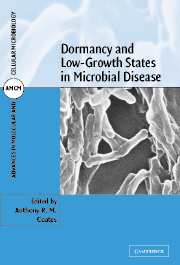Book contents
- Frontmatter
- Contents
- Contributors
- Preface
- 1 Physiological and molecular aspects of growth, non-growth, culturability and viability in bacteria
- 2 Survival of environmental and host-associated stress
- 3 Surviving the immune response: an immunologist's perspective
- 4 Quantitative and qualitative changes in bacterial activity controlled by interbacterial signalling
- 5 Mechanisms of stationary-phase mutagenesis in bacteria and their relevance to antibiotic resistance
- 6 Biofilms, dormancy and resistance
- 7 Tuberculosis
- 8 Gastritis and peptic ulceration
- 9 Resumption of yeast cell proliferation from stationary phase
- 10 Resting state in seeds of higher plants: dormancy, persistence and resilience to abiotic and biotic stresses
- Index
- Plate section
10 - Resting state in seeds of higher plants: dormancy, persistence and resilience to abiotic and biotic stresses
Published online by Cambridge University Press: 18 August 2009
- Frontmatter
- Contents
- Contributors
- Preface
- 1 Physiological and molecular aspects of growth, non-growth, culturability and viability in bacteria
- 2 Survival of environmental and host-associated stress
- 3 Surviving the immune response: an immunologist's perspective
- 4 Quantitative and qualitative changes in bacterial activity controlled by interbacterial signalling
- 5 Mechanisms of stationary-phase mutagenesis in bacteria and their relevance to antibiotic resistance
- 6 Biofilms, dormancy and resistance
- 7 Tuberculosis
- 8 Gastritis and peptic ulceration
- 9 Resumption of yeast cell proliferation from stationary phase
- 10 Resting state in seeds of higher plants: dormancy, persistence and resilience to abiotic and biotic stresses
- Index
- Plate section
Summary
INTRODUCTION
Changes in the physical environment, particularly in relation to temperature, light, humidity and gaseous atmosphere, limit the growth of all organisms and promote entry into a long-term persistent, “dormant” state. Of these, probably moisture and temperature are the most important. At high humidities (>99%), organisms tend to grow at an unhindered rate. However, dehydration towards 90% relative humidity (RH) severely reduces metabolism and growth of plants, fungi, yeast and animals. For example, nematodes coil and Fusarium hyphae become stationary when RH is reduced (45). To facilitate survival of such high levels of desiccation, a complex sequence of biochemical changes is needed that safely down regulates biosynthetic pathways. For example in seeds, the accumulation of pernicious compounds (such as free radicals/activated oxygen and lipid peroxidation products) is avoided, and/or counteracted by the accumulation of protectants like tocopherols (60). In seeds, the point of growth cessation has been estimated to be around–2 to–4 MPa (∼99% RH). Seeds fail to germinate below this water potential, although metabolism, e.g., respiration, only ceases at about –15 MPa (∼90% RH) (73). Below this water potential, insufficient water means relative metabolic stasis and enhanced longevity as further moisture is withdrawn down to around –250 MPa (∼15% RH). It is not just the seeds (sporophytes) of many higher plants which can tolerate such an environment, but also vegetative tissue (gametophyte) of a small number of plants (the resurrection plants).
- Type
- Chapter
- Information
- Dormancy and Low Growth States in Microbial Disease , pp. 235 - 264Publisher: Cambridge University PressPrint publication year: 2003

